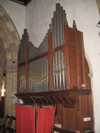For this church:    |
Whatton St John of BeverleyOrgan
In 1870 the original tower and spire was dismantled and rebuilt. Previously the five bells had been rung from the floor of the chancel but the new design incorporated a ringing room reached by a staircase on the outside of church on the south side. The old Norman arch which could be seen on the south side of the old tower was rebuilt on the north side of the new tower and later accommodated the new organ. An appeal was made for funds to pay for a new pipe organ and the following amounts were donated:

The organ was opened on Thursday 19th April 1877 with two special services: At 11.00am the Clergy and Choir processed from the Vicarage singing “Saviour, Blessed Saviour” from the south door. Prayers were intoned by Revd N Keymer. The Venite and Psalms were sung to Anglican chants. The Te Deum to a setting by W S Pratten and the Benedictus to a chant by Barnby. The anthem was the solo “O thou that tellest” sung by Mr Radcliffe of London. The Sermon was preached by Revd H Bather MA, Vicar of Meole Brace, Shropshire. Mr A Cellior late organist of St Alban’s, Holborn presided at the organ. Other hymns were “The strife is o’er” and “The church’s one foundation”. The second service was at 6.30pm when Mr W White, organist of St Paul’s, Nottingham presided at the organ. The Revd F Hall intoned the Service and the Revd W Walsham Howe, MA canon of St Asaph and Rector of Whittingham preached the Sermon. Hymns were “Light’s abode, celestial Salem”, the anthem “Praise the Lord of Jerusalem”, “Now thank we all our God”, “Come ye faithful, raise the anthem”, “Onward Christian Soldiers”. Records show that the harmonium was played by Thomas Henry Greasley until it was replaced by the pipe organ. The resident organist and choirmistress was then Miss Mary Hall, daughter of the Squire, Thomas Dickinson Hall and sister of the Revd Thomas Kenrick Hall. She taught Thomas Henry Greasley to play the pipe organ and there is a photograph of the choir taken c1877. The Revd T K Hall, Miss Mary Hall, John Greasley and his son Thomas Henry are the only persons that can be identified. Further improvements were made to the area around the organ when during 1879 £75 8s 7d was raised (£66 9s 6d from members of the Hall family) to pay Simpson & Sons of London for the encaustic tiles and iron gratings (£29 7s 6d), Mr Sam White was paid £40 18s 0d for oak seats and platforms and Mr Bates £5 3s 1d for the brickwork for the area under the tower. |






